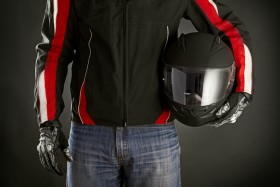Protective Gear Every Motorcyclist Needs to Have

When riding a motorcycle, there are several risks that inherently come along with it. Since motorcycles are not enclosed vehicles, they don’t have the safety features cars do. Motorcycles are less visible than cars on the road. Because motorcycles only have two wheels, they have less stability when making emergency moves like swerving. In 2011, the number of deaths per mile traveled was 30 times higher for motorcycles than it was for cars.
The best way to have the fun of riding your bike, but reduce the risk of being injured or killed in a motorcycle accident is to have the proper safety gear to shield your body from the road and the elements.
Helmet
A good helmet is the most important piece of safety gear a motorcyclist can have. Regardless of whether or not you are legally required to wear a helmet, the statistics don’t lie: helmets save lives. Unhelmeted riders are 3 times more likely to sustain a traumatic brain injury during an accident and wearing a helmet reduces the risk of dying in an accident by 37%. In 2010 alone, helmets saved the lives of 1,544 motorcyclists.
Many people who don’t wear helmets while riding claim helmets interfere with their field of vision, block out important sounds, or are simply uncomfortable to wear. All of these claims are simply not true. Full-face motorcycle helmets are required to provide at least 105 degrees of peripheral vision. When looking for a motorcycle helmet, go to a brick-and-mortar store and try them on to find one that fits properly. A helmet should fit your head snugly, but without any points of pressure. Helmets that fit correctly should be comfortable to wear.
You don’t need to spend a lot of money to get a good quality helmet. Make sure the helmet you purchase has a sticker indicating it has been approved by the Department of Transportation (DOT). You might also see helmets approved by Snell, a non-profit organization that tests how well helmets withstand impacts. For maximum protection, go with a full-face helmet rather than a ¾ helmet or half helmet. Motorcycle helmets should be replaced every five years or after being in an accident, which ever happens first.
Gloves
Whether a person is falling off a motorcycle or tripping on a piece of uneven sidewalk, they instinctively try to use their hands to break their fall. But when you’re falling off a motorcycle, your hands are likely to get significantly more damage than just a few minor scrapes, so it makes sense to invest in good protection for your hands. Motorcycle gloves should not only protect your knuckles and the tops of your hands, but also your palms, since those are more likely to come in direct contact with the pavement with the most force. Look for gloves that have a wrist strap to keep the gloves on securely if you are in an accident.
Good motorcycle gloves should protect the wearer from the pavement and the elements. Even if it’s not terribly cold out, it can feel a lot colder when you’re out for a ride. Look for motorcycle gloves that have plenty of insulation to keep wind and water away from your skin.
Body Armor
The more you cover your body, the better, and that’s where body armor comes in. It might seem excessive or like a hassle to put on armor that fully covers your arms, chest, back, and legs, but armor protects your skin, bones, and organs from being damaged in an accident. You might see things like jackets with built in elbow armor, but that only offers protection for your elbows and not the rest of your arms. Body armor should fit close to your body; armor that is too loose will move out of place in an accident. Look for armor rated “CE1” or “CE2.”
Boots
You need boots to protect your feet and ankles from the pavement, road debris, and burns from exhaust pipes. Motorcycle boots should cover both your feet and ankles, if not more of your legs. Look for boots with a nice, stiff, rubber sole, which can do a good job of gripping the pavement and your bike’s pegs. Boots with a heel can also help you maintain a better grip on your bike’s pegs. Motorcycle boots should be made of a sturdy material like leather and ideally have reinforcements in areas like the ankle.
Our personal injury attorneys at the Law Offices of Goodwin & Scieszka handle other vehicle-related claims, like truck accident claims and car accident cases. Contact us to see how we can help you receive fair compensation for your trouble.






